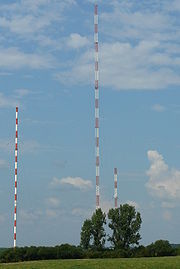
Cremlingen transmitter
Encyclopedia

Mediumwave
Medium wave is the part of the medium frequency radio band used mainly for AM radio broadcasting. For Europe the MW band ranges from 526.5 kHz to 1606.5 kHz...
transmission facility established in 1962 for transmitting the program of Deutschlandfunk
Deutschlandfunk
Deutschlandfunk is a German public broadcasting radio station, broadcasting national news and current affairs.-History:Broadcasting in the Federal Republic of Germany is reserved under the Basic Law to the states. This means that all public broadcasting is regionalised...
on 756 kHz near Cremlingen
Cremlingen
Cremlingen is a municipality in the district of Wolfenbüttel, Lower Saxony, Germany. It borders Lehre, Königslutter, Sickte, and Braunschweig. Parts of it are adjacent to the Elm hills.-History:...
-Abbenrode.
The first transmitter was installed in 1962. It transmitted the program of Deutschlandfunk on 756 kHz and used as its aerial a 137-metre-high guyed
Guy-wire
A guy-wire or guy-rope, also known as simply a guy, is a tensioned cable designed to add stability to structures . One end of the cable is attached to the structure, and the other is anchored to the ground at a distance from the structure's base...
steel
Steel
Steel is an alloy that consists mostly of iron and has a carbon content between 0.2% and 2.1% by weight, depending on the grade. Carbon is the most common alloying material for iron, but various other alloying elements are used, such as manganese, chromium, vanadium, and tungsten...
framework mast
Radio masts and towers
Radio masts and towers are, typically, tall structures designed to support antennas for telecommunications and broadcasting, including television. They are among the tallest man-made structures...
. In 1964/65 a second transmitter for the propagation of Deutschlandfunk on 548 kHz was installed. It used as its aerial a 240-metre-high guyed steel tube mast, which was insulated against the ground in combination with an insulated guyed steel framework mast for a radiation pattern with a minimum towards the southeast.
According to the Geneva plan, only one transmitter on 756 kHz with a maximum power of 800 kilowatts and a maximum power of 200 kilowatts with a radiation minimum towards the southeast was allowed. Therefore the height of the steel tube mast was reduced from 240 metres to 188 metres to optimize it for 756 kHz. Also the height of the steel framework mast, which was used until 1978 for a directional aerial for 548 kHz was shortened. Its height has since been 199.99 metres. The height of the 137-metre mast was not changed, because its height is optimized for 756 kHz and was used after 1978 as backup aerial.
Until the middle of the 1990s the transmission power was 800 kilowatts in the daytime and 200 kilowatts at nighttime. Since the middle of the 1990s transmission power has been 200 kilowatts at nighttime as well as in the daytime.
From 2001 to 2003 the program of the pop music radio MEGARADIO
Megaradio
Megaradio was a German-speaking privately owned radio station, which transmitted on several frequencies from transmission facilities in Germany . Its content was a German-speaking pop music programs...
was transmitted on 630 kHz using the 137-metre-high radio mast as its aerial. This was made possible after this frequency, which had been used from 1978 until the mid-1990s for transmissions of SFB
Sender Freies Berlin
Sender Freies Berlin was the ARD public radio and television service for West Berlin from 1 June 1954 until 1990 and for Berlin as a whole from German reunification until 30 April 2003...
and NDR
Norddeutscher Rundfunk
Norddeutscher Rundfunk is a public radio and television broadcaster, based in Hamburg. In addition to the city-state of Hamburg, NDR transmits for the German states of Lower Saxony, Mecklenburg-Vorpommern and Schleswig-Holstein...
on 630 kHz from the Dannenberg transmitter in the daytime, had been recoordinated for 24-hour transmission from the Cremlingen transmitter.
External links
- Diagrams of the masts
- Diagrams of the masts
- Diagrams of the masts
- http://maps.google.com/maps?ie=UTF8&z=15&ll=52.293805,10.726781&spn=0.010447,0.028925&t=h&om=1

